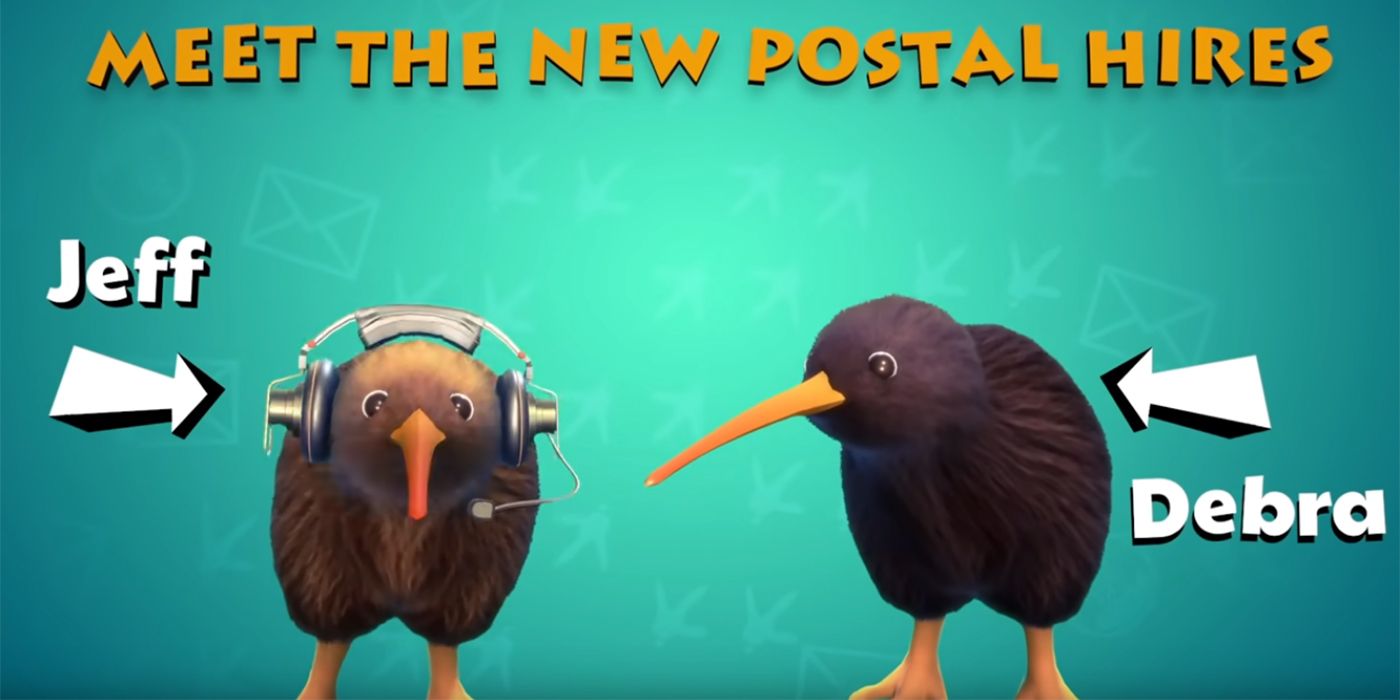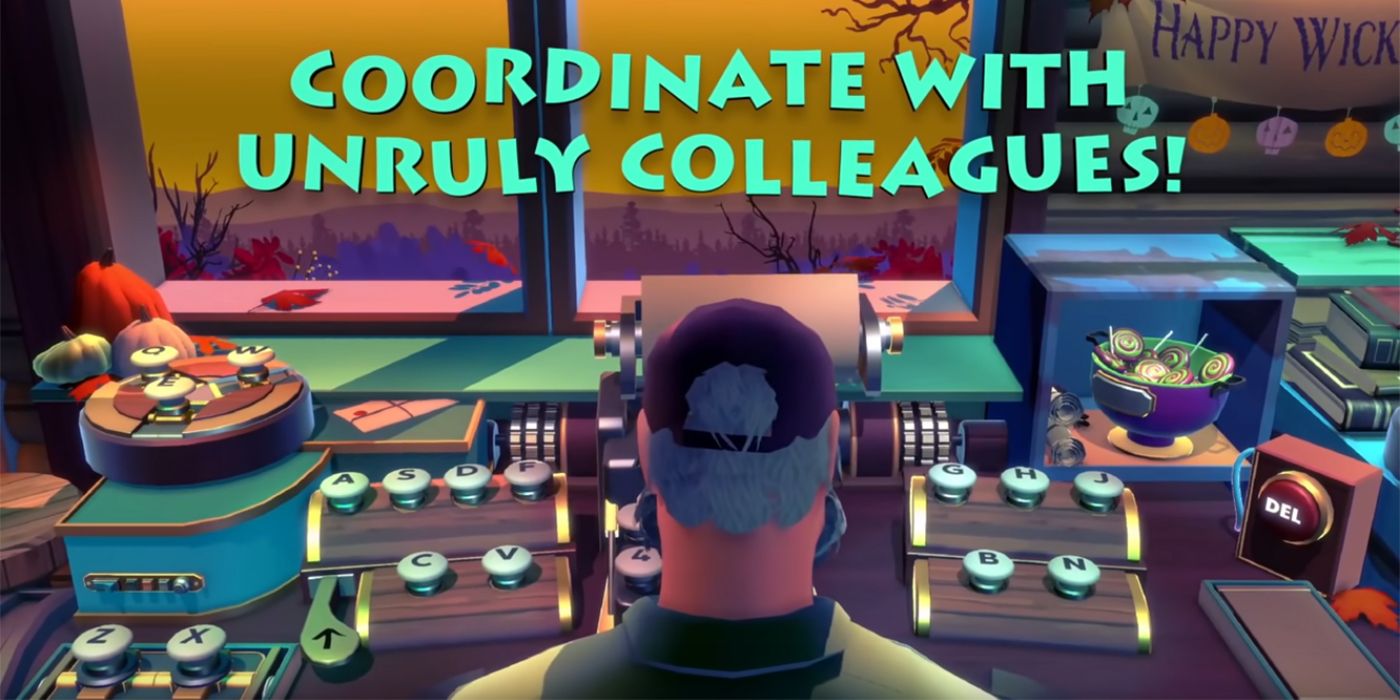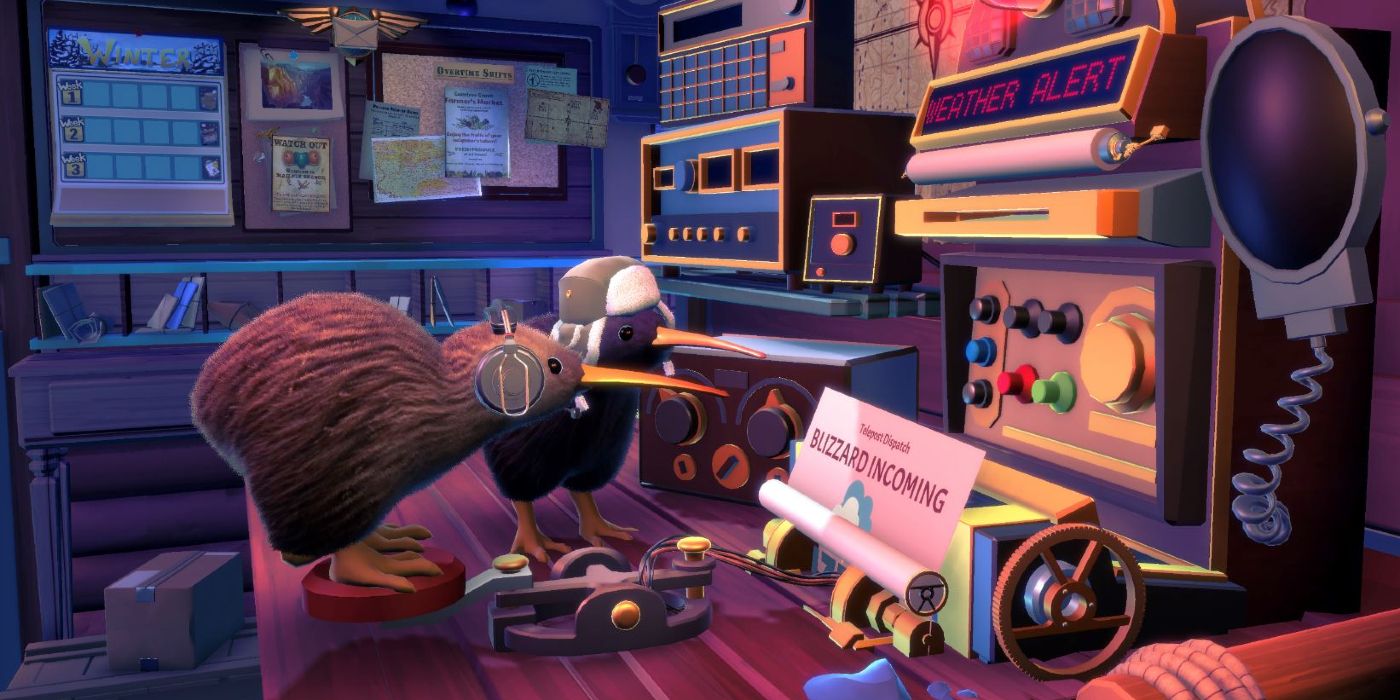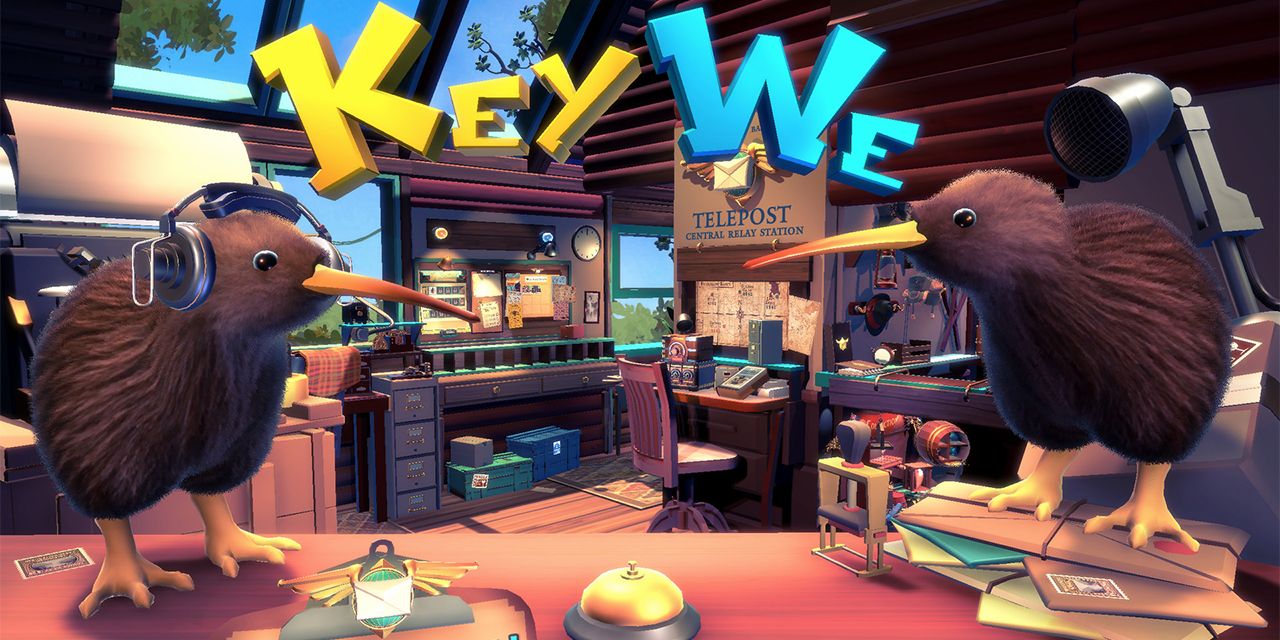In Bungalow Basin, animals and humans live and work together in harmony. This is where the player will find Jeff and Debra, two flightless birds getting their start in the postal business and as the stars of the upcoming puzzle-platformer, KeyWe. Taking the role as one or both of the birds, the multiplayer-optional KeyWe takes Jeff and Debra through an entire year of working the different rooms in the Telepost building. From writing correspondence to feeding the Cassowaries, the player will have to figure out the increasingly difficult levels while also coordinating with the other bird in the room.
This is the first game from the indie development team Stonewheat and Sons, who first prototyped the game at Global Game Jam 2018 with a team of only four developers. Recently, Game Rant was able to sit down with Joel Davis and Grant Gessel from Stonewheat and Sons to discuss the game. With their numbers shrunk to three, the team feels the weight that comes with creating a game from scratch, not having the same resources as a bigger developer.
Q: Why did you decide on Kiwis as the game's mascot?
Joel: It just seemed like the obvious choice. We prototyped KeyWe during Global Game Jam 2018, I think it was. We had 48 hours to make a game, the four of us. There’s a theme of the event, which was “transmission,” and they were like “Interpret that however you want, whether by radio, or virus, or whatever.” Also, we picked some random modifiers that they had to help you narrow your game down. One was “Your game must contain a bird protagonist.” We were just kind of brainstorming ideas and we liked the idea of postal birds that couldn’t fly, had to work a desk job instead. We were thinking “What would that look like?” and we ended up sketching a kiwi bird wearing a radio headset. We were like “That’s a powerful image.”
So the prototype of the game was just them running around on the keyboard and typing with their butts as if they were the left and right hands. They’re an often overlooked bird, especially in the states. We've had people ask us “Is that a real…?” Sometimes we joke that nature gave us the cutest character design.
Q: In your opinion, what is the hardest mini-game, why?
Grant: Later on, probably some of the typing levels. Just because you have to work pretty well with your teammate in some of the later levels. That was the first game we made and sort of the Genesis of the game. There was something about the cooperative awareness that you need when you’re playing that level. Because it’s typing, and words are a specific sequence of letters, you have to be kind of aware of what your partner is doing and what letters they’re close to.
Joel: In the winter levels we really tried to have it where that keyboard is not static. So during one of the holiday-themed levels during Winter… The typing desk has all of this internal machinery that is sort of mysterious in that no one knows quite how it works, it’s like this old antique fixture of the Telepost office.
Grant: Juliette.
Joel: Her name is Juliette, yeah. She has this unpredictable charm.
Grant: She goes into holiday mode.
Joel: So during HollyJostle, which is the Winter Holiday in Bungalow, all the modules flip over and we have a train set the letters are on. You’re also typing two messages at once during winter so that one is pretty epic.
Q: Did any other media serve as an inspiration for any of the mechanics or design elements in KeyWe?
Grant: So this is kind of a random one, and I don’t know how much it influenced the others, maybe Joel, but books by a fantasy author named Terry Pratchett. Joel and I have both read Going Postal. Contrary to the weird-sounding name, it’s about a guy who, in this whimsical fantasy setting, creates a post office. It’s just like a fun fantastical story about postal letters and it’s kinda like that “heroic civil servant.”
Joel: I think it was definitely an inspiration, at least in terms of like “Hey if you make it fun enough, you can make the most boring sounding thing fun.” In the sense of the characters being small creatures in a big world, The Rescuers and The Rescuers Down Under animated movies. Ferngully, Secret of Nimh, definitely older animated movies that we watched as kids were the inspiration for that. Then the human-sized instruments become this kind of landscape.
Grant: I would probably say that a big inspiration for me in terms of modeling, I used to play a lot of Rare games growing up like Banjo & Kazooie and Conker’s Bad Fur Day. I really love that art style, really big broad shapes.
Joel: And we ended up wanting all our menus to be 3D and super thematic, so we ended up where the main menu is the actual post office.
Q: Will the game receive any content updates after its initial release?
Joel: We can’t officially talk about anything, but I will say we have a ton of ideas for future stuff, and so hopefully if there’s an opportunity to do more KeyWe stuff, it’s something we would definitely like to do.
Grant: When we were planning out the game, we kinda failed at this, but we were like “Let’s not over plan it.” And we immediately brainstormed a ton of stuff that was impossible to do so there’s a bunch of ideas that we’ve had.
Q: How does the gameplay experience change between a single-player and co-op mode?
Grant: Singleplayer and Co-op, I think they definitely feel different and they each definitely have their own charm. I recently played a game called Brothers, where you play two brothers and control them at the same time. I played that by myself. So if you want, you can do that single-player Brother’s thing with the dual wield controls and joysticks. It’s like a weird mental gymnastics thing you have to do, and I think it’s pretty fun.
Once you get used to it, it’s really interesting. It’s like your left and right hands and you’re moving your hands around at the same time trying to do stuff. The hot-swap is more natural but you can’t take advantage of the two Kiwi’s quite as well but you can still move them both at the same time. There are a bunch of cool little tricks you can figure out to do things more efficiently, or leave the kiwis somewhere.
In multiplayer it’s more about communication and I think that’s kind of where the original idea began. There’s coordination, and it’s harder in some ways because you actually have to coordinate whereas with yourself you just know what you want to do. We’ve taken the game to a lot of conventions and seen people play and one thing that we’ve noticed is when people are new to the game they just kind of follow each other around. But you really gotta split up. If you don’t know what your partner wants to do like we’ve had people come to play the game who don’t know each other and they just kind of sit there silently. Coordination is more important.
Joel: It’s really cool at conventions, the sort of flip side of that, when two people are complete strangers start talking to each other while they’re playing, like “Okay, I’ll do this, you do this,” and just trying to figure out, “Oh we both have to hit this button at the same time.”
Q: What posed the biggest challenge during development?
Grant: That’s a...uh, that’s a complicated question. Well, I would probably say the obvious answer is –
Joel: Making a game.
Grant: This is like our first game, so everything is just like new. We’ve all worked together, and I’d say we’ve all got 8/9 years working in gaming. So we kinda understand the development cycle but when you’re doing something by yourself there are so many more things you have to worry about. Talking to people like you, payroll management and it’s just tough.
Every process is like a totally new thing for us. Even just developing an idea into a full-fledged product, something that someone can sit down and invest their time into and feel satisfied with the stuff there, yeah it’s tough. Making a game is tough, and we joke that it’s one of the hardest things, we think, because it involves every part of the digital media process. Engineering, art design, gameplay design, UI design, audio, there’s all the aspects of visual art and then there are all kinds of specific problem-solving things you have to do. It’s like we spend more time doing things not development-related.
Joel: Yeah, we’re making a game but we’re also running a company. I think just figuring out our development processes. The Stonewheat approach is to process everything and document everything so we know from conflict resolutions to design to our concept art, “What is the process?” We can always go back to the process. So that has been a really helpful thing to do, and then just picking our focus because there are only three of us.
We’re a fairly multidisciplinary team, what is most important for us to spend our time on? Is it adding this new piece of art, or really making sure this mechanic feels good? What needs our attention most at this time? That prioritization has been a big challenge while at the same time being one of the biggest areas where we have learned and grown as a team. It was definitely a struggle at the beginning, there was so much to do. But we start.
Grant: I think that as a whole, attention as a resource thing, we have a term called “Bangbuck” where it’s “What’s gonna get you the most bang for your buck?” We’ve acquired peers who’re working on their own games. It seems like a problem with indie developers, especially new developers, on figuring out what to work on and what’s gonna help move forward towards its realization.
As an artist, one of the things I’ve learned is you gotta get stuff in-engine. You gotta play it to really see how it fits into the game and you can’t just work in your own little silo. You gotta be able to cut through all your perfectionism and be like, “It’s not final, let’s just get it in and test it.” So, yeah, developing our processes is definitely one of the most useful things. There’s gonna be all kinds of things you’re going to have to do. All these other companies have developed processes over the years. You’re starting with nothing and you gotta make sure you sit down and think about that. Here’s this thing we’re doing, so what’s a good way to do it? At our last job, one of the things that were frustrating is that no one would document anything.
Q: Is there anything else you’d like to add?
Joel: Well there is something we haven’t talked about a ton in KeyWe and that’s the collection system. So you could see this in the main menu in the demo, but you couldn’t go into it. Underneath the wardrobe, Jeff and Debra have a nest down there with little cubbies, and throughout the game, there are collectible items that are hidden through puzzles you have to unlock. When you solve this collectible item, you’ll find something like “ancient dinosaur tooth,” and so those have a riddle that will point you in the right direction. We haven’t shown the system off too much yet but that’s what we’re doing right now is polishing off all those puzzles to make sure they’re all animated, have sound effects, and everything.
Grant: They’re like built-in secrets.
Joel: It’s also another way to get customization items for your Kiwi, so some might give an astronaut helmet or a dinosaur skull that you only get through finding that collectible.
[End]
KeyWe is set to release on August 31, 2021, for PC, PS4, PS5, Switch, Xbox One, and Xbox Series X/S.




